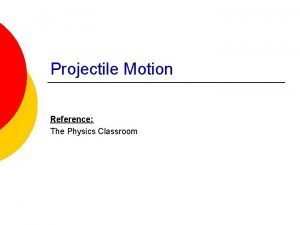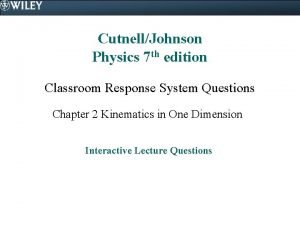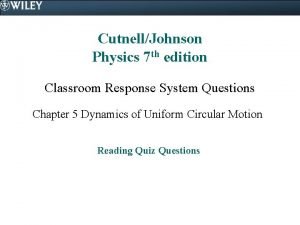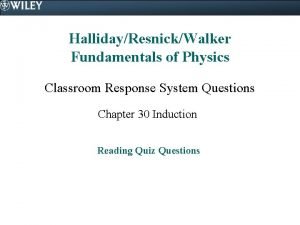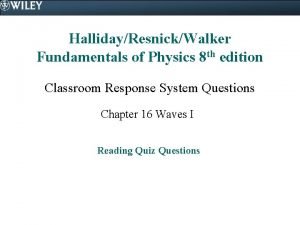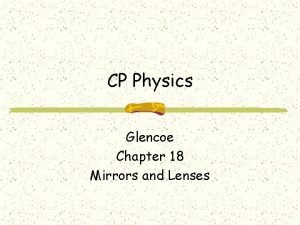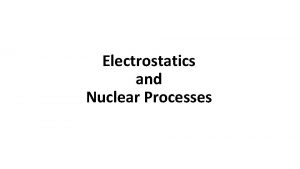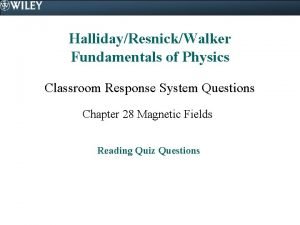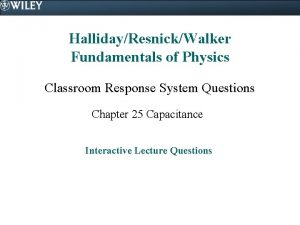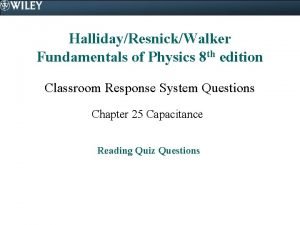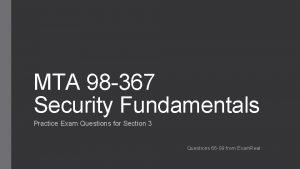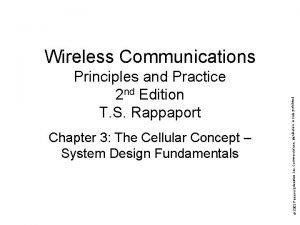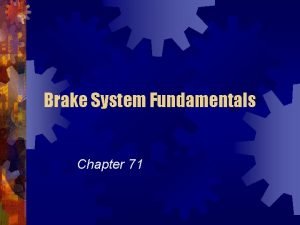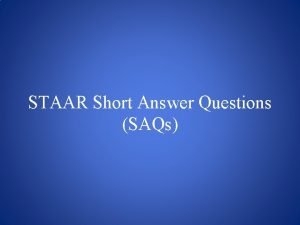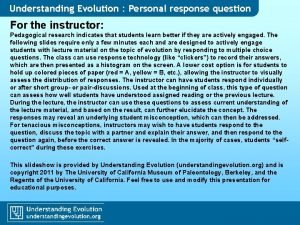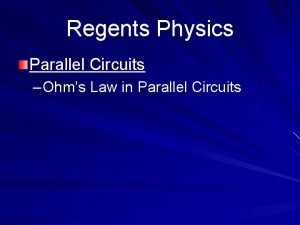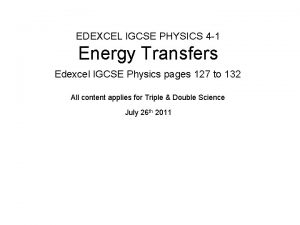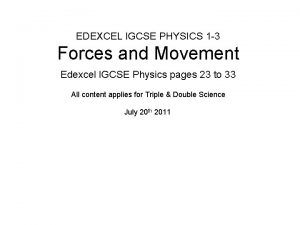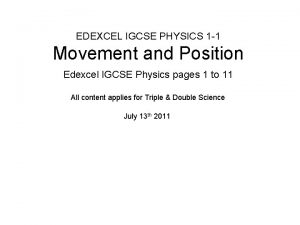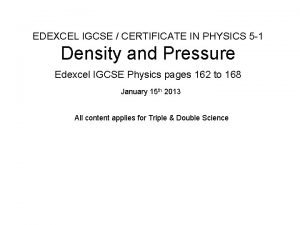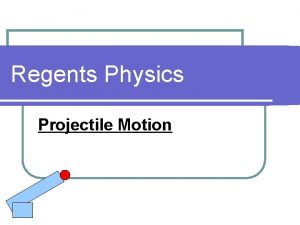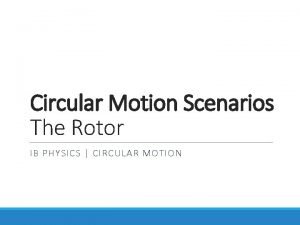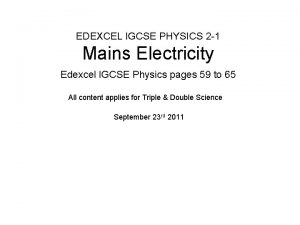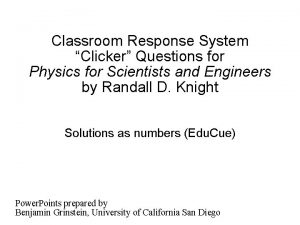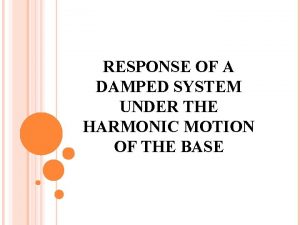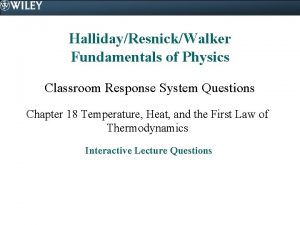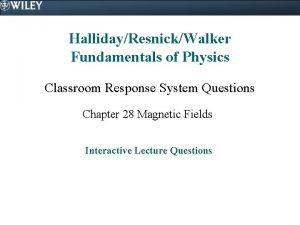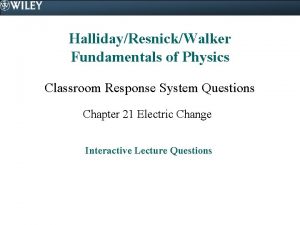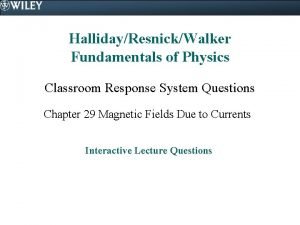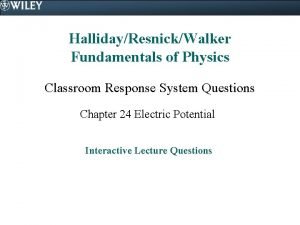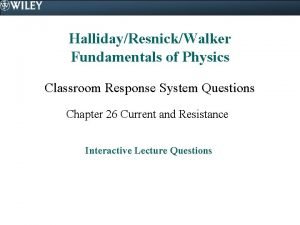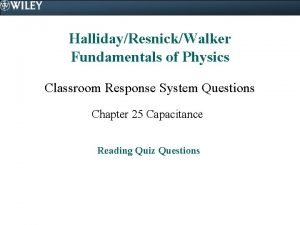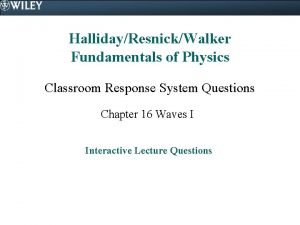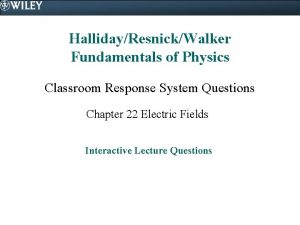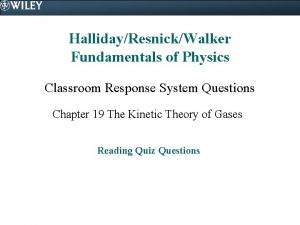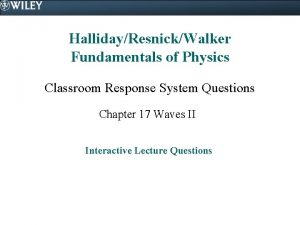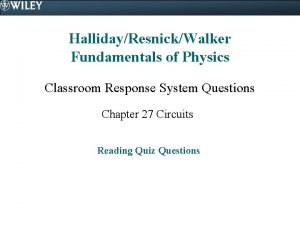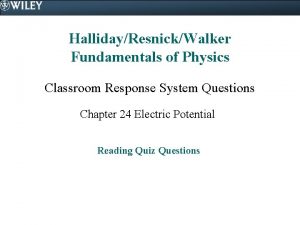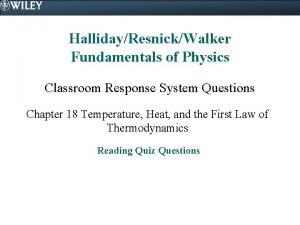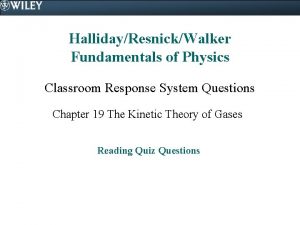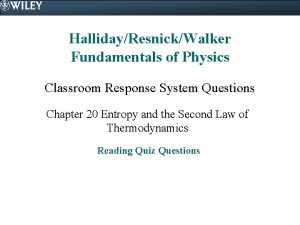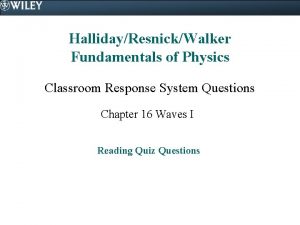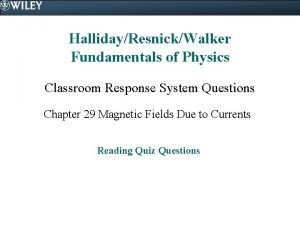HallidayResnickWalker Fundamentals of Physics Classroom Response System Questions



















































- Slides: 51

Halliday/Resnick/Walker Fundamentals of Physics Classroom Response System Questions Chapter 19 The Kinetic Theory of Gases Interactive Lecture Questions

19. 2. 1. In 1865, Loschmidt calculated the number of molecules in a cubic centimeter of a gas under standard temperature and pressure conditions. He later used this number to estimate the size of an individual gas molecule. Calculate Loschmidt’s number for helium using the density, the atomic mass, and Avogadro’s number. a) 2. 7 1019 atoms/cm 3 b) 3. 5 1020 atoms/cm 3 c) 4. 1 1021 atoms/cm 3 d) 5. 4 1022 atoms/cm 3 e) 6. 2 1023 atoms/cm 3

19. 2. 1. In 1865, Loschmidt calculated the number of molecules in a cubic centimeter of a gas under standard temperature and pressure conditions. He later used this number to estimate the size of an individual gas molecule. Calculate Loschmidt’s number for helium using the density, the atomic mass, and Avogadro’s number. a) 2. 7 1019 atoms/cm 3 b) 3. 5 1020 atoms/cm 3 c) 4. 1 1021 atoms/cm 3 d) 5. 4 1022 atoms/cm 3 e) 6. 2 1023 atoms/cm 3

19. 2. 2. Suppose water molecules (molecular mass = 0. 01802 kg/m 3) completely fill a container so that there is no empty space within the container. Using the density of water and Avogadro’s number, estimate the size of the water molecule. Hint: assume the water molecule fits within a cube and that these cubes are stacked to fill the volume of the container. a) 4 10 11 m b) 2 10 9 m c) 3 10 10 m d) 5 10 9 m e) 6 10 10 m

19. 2. 2. Suppose water molecules (molecular mass = 0. 01802 kg/m 3) completely fill a container so that there is no empty space within the container. Using the density of water and Avogadro’s number, estimate the size of the water molecule. Hint: assume the water molecule fits within a cube and that these cubes are stacked to fill the volume of the container. a) 4 10 11 m b) 2 10 9 m c) 3 10 10 m d) 5 10 9 m e) 6 10 10 m

19. 2. 3. The standard for determining atomic masses is the carbon-12 atom, so that the mass of one mole of carbon-12 is exactly twelve grams. What would Avogadro’s number and the atomic mass of oxygen-16 be if the standard were that one mole of hydrogen is exactly one gram? a) 6. 020 1023 mol 1, 15. 9898 grams b) 6. 069 1023 mol 1, 16. 1200 grams c) 5. 844 1023 mol 1, 15. 7845 grams d) 5. 975 1023 mol 1, 15. 8707 grams e) 6. 122 1023 mol 1, 16. 3749 grams

19. 2. 3. The standard for determining atomic masses is the carbon-12 atom, so that the mass of one mole of carbon-12 is exactly twelve grams. What would Avogadro’s number and the atomic mass of oxygen-16 be if the standard were that one mole of hydrogen is exactly one gram? a) 6. 020 1023 mol 1, 15. 9898 grams b) 6. 069 1023 mol 1, 16. 1200 grams c) 5. 844 1023 mol 1, 15. 7845 grams d) 5. 975 1023 mol 1, 15. 8707 grams e) 6. 122 1023 mol 1, 16. 3749 grams

19. 3. 1. Under which of the following circumstances does a real gas behave like an ideal gas? a) The gas particles move very slowly. b) The gas particles do not collide with each other very often. c) The interaction between the gas particles is negligible. d) The interaction between the gas particles and the walls of the container is negligible. e) There are only one kind of particles in the container.

19. 3. 1. Under which of the following circumstances does a real gas behave like an ideal gas? a) The gas particles move very slowly. b) The gas particles do not collide with each other very often. c) The interaction between the gas particles is negligible. d) The interaction between the gas particles and the walls of the container is negligible. e) There are only one kind of particles in the container.

19. 3. 2. Using the ideal gas law, estimate the approximate number of air particles within an otherwise empty room that has a height of 2. 5 m, a width of 4. 0 m, and a length of 5. 0 m. a) 1. 2 1027 b) 6. 8 1025 c) 3. 0 1026 d) 2. 5 1028 e) 9. 1 1024

19. 3. 2. Using the ideal gas law, estimate the approximate number of air particles within an otherwise empty room that has a height of 2. 5 m, a width of 4. 0 m, and a length of 5. 0 m. a) 1. 2 1027 b) 6. 8 1025 c) 3. 0 1026 d) 2. 5 1028 e) 9. 1 1024

19. 3. 3. An ideal gas is enclosed within a container by a moveable piston. If the final temperature is two times the initial temperature and the volume is reduced to one-fourth of its initial value, what will the final pressure of the gas be relative to its initial pressure, P 1? a) 8 P 1 b) 4 P 1 c) 2 P 1 d) P 1/2 e) P 1/4

19. 3. 3. An ideal gas is enclosed within a container by a moveable piston. If the final temperature is two times the initial temperature and the volume is reduced to one-fourth of its initial value, what will the final pressure of the gas be relative to its initial pressure, P 1? a) 8 P 1 b) 4 P 1 c) 2 P 1 d) P 1/2 e) P 1/4

19. 3. 4. Consider a commercial sightseeing hot air balloon that carries a basket with more than 20 passengers. Assume that balloon contains 1. 5 × 104 m 3 of air. Estimate the order of magnitude of the number of air molecules inside the balloon. a) 1023 b) 1029 c) 1035 d) 1018 e) 104

19. 3. 4. Consider a commercial sightseeing hot air balloon that carries a basket with more than 20 passengers. Assume that balloon contains 1. 5 × 104 m 3 of air. Estimate the order of magnitude of the number of air molecules inside the balloon. a) 1023 b) 1029 c) 1035 d) 1018 e) 104

19. 4. 1. Two sealed containers, labeled A and B as shown, are at the same temperature and each contain the same number of moles of an ideal monatomic gas. Which one of the following statements concerning these containers is true? a) The rms speed of the atoms in the gas is greater in B than in A. b) The frequency of collisions of the atoms with the walls of container B is greater than that for container A. c) The kinetic energy of the atoms in the gas is greater in B than in A. d) The pressure within container B is less than the pressure inside container A. e) The force that the atoms exert on the walls of container B is greater than in for those in container A.

19. 4. 1. Two sealed containers, labeled A and B as shown, are at the same temperature and each contain the same number of moles of an ideal monatomic gas. Which one of the following statements concerning these containers is true? a) The rms speed of the atoms in the gas is greater in B than in A. b) The frequency of collisions of the atoms with the walls of container B is greater than that for container A. c) The kinetic energy of the atoms in the gas is greater in B than in A. d) The pressure within container B is less than the pressure inside container A. e) The force that the atoms exert on the walls of container B is greater than in for those in container A.

19. 4. 2. Two identical, sealed containers have the same volume. Both containers are filled with the same number of moles of gas at the same temperature and pressure. One of the containers is filled with helium gas and the other is filled with neon gas. Which one of the following statements concerning this situation is true? a) The speed of each of the helium atoms is the same value, but this speed is different than that of the neon atoms. b) The average kinetic energy of the neon atoms is greater than that of the helium atoms. c) The pressure within the container of helium is less than the pressure in the container of neon. d) The internal energy of the neon gas is greater than the internal energy of the helium gas. e) The rms speed of the neon atoms is less than that of the helium atoms.

19. 4. 2. Two identical, sealed containers have the same volume. Both containers are filled with the same number of moles of gas at the same temperature and pressure. One of the containers is filled with helium gas and the other is filled with neon gas. Which one of the following statements concerning this situation is true? a) The speed of each of the helium atoms is the same value, but this speed is different than that of the neon atoms. b) The average kinetic energy of the neon atoms is greater than that of the helium atoms. c) The pressure within the container of helium is less than the pressure in the container of neon. d) The internal energy of the neon gas is greater than the internal energy of the helium gas. e) The rms speed of the neon atoms is less than that of the helium atoms.

19. 4. 3. A monatomic gas is stored in a container with a constant volume. When the temperature of the gas is T, the rms speed of the atoms is vrms. What is the rms speed when the gas temperature is increased to 3 T? a) vrms/9 b) c) 3 vrms d) vrms e) 9 vrms

19. 4. 3. A monatomic gas is stored in a container with a constant volume. When the temperature of the gas is T, the rms speed of the atoms is vrms. What is the rms speed when the gas temperature is increased to 3 T? a) vrms/9 b) c) 3 vrms d) vrms e) 9 vrms

19. 5. 1. Closed containers A and B both contain helium gas at the same temperature. There are n atoms in container A and 2 n atoms in container B. At time t = 0 s, all of the helium atoms have the same kinetic energy. The atoms have collisions with each other and with the walls of the container. After a long time has passed, which of the following statements will be true? a) The atoms in both containers have the same kinetic energies they had at time t = 0 s. b) The atoms in both containers have a wide range of speeds, but the distributions of speeds are the same for both A and B. c) The average kinetic energy for atoms in container B is higher than that for container A. d) The average kinetic energy for atoms in container A is higher than that for container B. e) The atoms in both containers have a wide range of speeds, but the distributions of speeds has a greater range for container B than that for container A.

19. 5. 1. Closed containers A and B both contain helium gas at the same temperature. There are n atoms in container A and 2 n atoms in container B. At time t = 0 s, all of the helium atoms have the same kinetic energy. The atoms have collisions with each other and with the walls of the container. After a long time has passed, which of the following statements will be true? a) The atoms in both containers have the same kinetic energies they had at time t = 0 s. b) The atoms in both containers have a wide range of speeds, but the distributions of speeds are the same for both A and B. c) The average kinetic energy for atoms in container B is higher than that for container A. d) The average kinetic energy for atoms in container A is higher than that for container B. e) The atoms in both containers have a wide range of speeds, but the distributions of speeds has a greater range for container B than that for container A.

19. 5. 2. Assume that you have a container with 0. 25 kg of helium gas at 20 C. How much energy must be added to the gas to increase its temperature to 70 C? a) 4 × 104 J b) 2 × 105 J c) 5 × 106 J d) 1 × 107 J e) 3 × 108 J

19. 5. 2. Assume that you have a container with 0. 25 kg of helium gas at 20 C. How much energy must be added to the gas to increase its temperature to 70 C? a) 4 × 104 J b) 2 × 105 J c) 5 × 106 J d) 1 × 107 J e) 3 × 108 J

19. 6. 1. Adjusting which of the following parameters will cause a significant increase in the mean free path of the average molecule in a gas? a) decrease the temperature b) decrease the average velocity c) increase the temperature d) decrease the diameter e) increase the diameter

19. 6. 1. Adjusting which of the following parameters will cause a significant increase in the mean free path of the average molecule in a gas? a) decrease the temperature b) decrease the average velocity c) increase the temperature d) decrease the diameter e) increase the diameter

19. 6. 2. At sea level, the mean free path of air molecules is approximately 6 × 10 8 m. At an altitude of 100 km, the mean free path is approximately 0. 1 m. Which one of the following statements best explains this difference in mean free path? Assume that the air behaves as an ideal gas. a) The diameter of air molecules is smaller at high altitudes than it is at sea level. b) The air temperature is lower at high altitudes than it is at sea level. c) The air pressure is higher at high altitudes than it is at sea level. d) The air concentration is smaller at high altitudes than it is at sea level. e) The diameter of air molecules is larger at high altitudes than it is at sea level.

19. 6. 2. At sea level, the mean free path of air molecules is approximately 6 × 10 8 m. At an altitude of 100 km, the mean free path is approximately 0. 1 m. Which one of the following statements best explains this difference in mean free path? Assume that the air behaves as an ideal gas. a) The diameter of air molecules is smaller at high altitudes than it is at sea level. b) The air temperature is lower at high altitudes than it is at sea level. c) The air pressure is higher at high altitudes than it is at sea level. d) The air concentration is smaller at high altitudes than it is at sea level. e) The diameter of air molecules is larger at high altitudes than it is at sea level.

19. 7. 1. Using Maxwell’s speed law, determine the ratio of the probability for gas molecules at 250 K to have a speed of 250 m/s to the probability of gas molecules at 150 K to have the same speed. The molar mass of the gas molecules is 39. 9 g/mol. a) 0. 69 b) 0. 60 c) 0. 46 d) 0. 40 e) 0. 28

19. 7. 1. Using Maxwell’s speed law, determine the ratio of the probability for gas molecules at 250 K to have a speed of 250 m/s to the probability of gas molecules at 150 K to have the same speed. The molar mass of the gas molecules is 39. 9 g/mol. a) 0. 69 b) 0. 60 c) 0. 46 d) 0. 40 e) 0. 28

19. 7. 2. One mole of helium gas (M = 4. 00 g/mol) are enclosed by a sealed container. The gas is maintained at a constant temperature of 273 K. What is the most probable speed of particles in the gas? a) 445 m/s b) 790 m/s c) 1070 m/s d) 1180 m/s e) 1310 m/s

19. 7. 2. One mole of helium gas (M = 4. 00 g/mol) are enclosed by a sealed container. The gas is maintained at a constant temperature of 273 K. What is the most probable speed of particles in the gas? a) 445 m/s b) 790 m/s c) 1070 m/s d) 1180 m/s e) 1310 m/s

19. 9. 1. A monatomic gas particle has only 3 degrees of freedom; and each particle in the gas has a thermal energy equal to (3/2)k. T. How many degrees of freedom does a diatomic gas particle have and how much thermal energy does each molecule have? a) 2, k. T b) 3, (3/2)k. T c) 4, 2 k. T d) 5, (5/2)k. T e) 6, 3 k. T

19. 9. 1. A monatomic gas particle has only 3 degrees of freedom; and each particle in the gas has a thermal energy equal to (3/2)k. T. How many degrees of freedom does a diatomic gas particle have and how much thermal energy does each molecule have? a) 2, k. T b) 3, (3/2)k. T c) 4, 2 k. T d) 5, (5/2)k. T e) 6, 3 k. T

19. 11. 1. In which of the following cases is a system undergoing an isobaric process? a) The system is placed within a thermal bath held at constant temperature. b) The system is an ideal gas enclosed in a container with a piston that may move up or down. A heavy object is placed on top of the piston. c) The system is an ideal gas enclosed in a container that is in contact with an object that is continually kept warmer or cooler than the gas within the system. d) The system is an ideal gas enclosed in a container has a constant volume. e) The system is an ideal gas enclosed in a container that is connected to a source of the gas from which gas may be added or removed to maintain a constant pressure.

19. 11. 1. In which of the following cases is a system undergoing an isobaric process? a) The system is placed within a thermal bath held at constant temperature. b) The system is an ideal gas enclosed in a container with a piston that may move up or down. A heavy object is placed on top of the piston. c) The system is an ideal gas enclosed in a container that is in contact with an object that is continually kept warmer or cooler than the gas within the system. d) The system is an ideal gas enclosed in a container has a constant volume. e) The system is an ideal gas enclosed in a container that is connected to a source of the gas from which gas may be added or removed to maintain a constant pressure.

19. 11. 2. In which of the following cases is a system undergoing an adiabatic process? a) The system is placed within a thermal bath held at constant temperature. b) The system is an ideal gas enclosed in a container with a piston that may move up or down. A heavy object is placed on top of the piston. c) The system is an ideal gas enclosed in a container that is in contact with an object that is continually kept warmer or cooler than the gas within the system. d) The system is an ideal gas enclosed in a container has a constant volume. e) The system volume is changed rapidly.

19. 11. 2. In which of the following cases is a system undergoing an adiabatic process? a) The system is placed within a thermal bath held at constant temperature. b) The system is an ideal gas enclosed in a container with a piston that may move up or down. A heavy object is placed on top of the piston. c) The system is an ideal gas enclosed in a container that is in contact with an object that is continually kept warmer or cooler than the gas within the system. d) The system is an ideal gas enclosed in a container has a constant volume. e) The system volume is changed rapidly.

19. 11. 3. Consider the following pressure-volume graphs. Which of these graphs represents the behavior of a gas undergoing free expansion? a) A b) B c) C d) D e) None of the graphs represent a gas undergoing free expansion.

19. 11. 3. Consider the following pressure-volume graphs. Which of these graphs represents the behavior of a gas undergoing free expansion? a) A b) B c) C d) D e) None of the graphs represent a gas undergoing free expansion.

19. 11. 4. Which one of the following statements best explains why only the starting and ending points may be plotted on a pressure-volume graph for a gas that is undergoing free expansion? a) The gas is not in thermal equilibrium. b) The gas is not enclosed by a volume. c) The temperature is changing rapidly. d) The increase in the internal energy of the gas is unknown. e) All of the above statements are true.

19. 11. 4. Which one of the following statements best explains why only the starting and ending points may be plotted on a pressure-volume graph for a gas that is undergoing free expansion? a) The gas is not in thermal equilibrium. b) The gas is not enclosed by a volume. c) The temperature is changing rapidly. d) The increase in the internal energy of the gas is unknown. e) All of the above statements are true.

19. 11. 5. A cylinder with adiabatic walls is closed on both ends. Inside there are two chambers that contain an ideal gas ( = 1. 5) at the same temperature and pressure. The two chambers are separated by moveable, frictionless piston that is also insulating. Initially the two chambers are of equal volumes. The righthand chamber contains a light bulb of negligible volume that when turned on delivers heat to this chamber. When the pressure in the right-hand chamber increases to eight times its initial value, what is the volume in the left-hand chamber relative to its initial value? a) V 0/4 b) V 0/2 c) V 0/8 d) V 0/16 e) V 0/64

19. 11. 5. A cylinder with adiabatic walls is closed on both ends. Inside there are two chambers that contain an ideal gas ( = 1. 5) at the same temperature and pressure. The two chambers are separated by moveable, frictionless piston that is also insulating. Initially the two chambers are of equal volumes. The righthand chamber contains a light bulb of negligible volume that when turned on delivers heat to this chamber. When the pressure in the right-hand chamber increases to eight times its initial value, what is the volume in the left-hand chamber relative to its initial value? a) V 0/4 b) V 0/2 c) V 0/8 d) V 0/16 e) V 0/64

19. 11. 6. A cylinder with a moveable piston contains an ideal gas. The gas is subsequently compressed adiabatically. Which of the following choices correctly identifies the signs of (1) the heat exchanged with the environment, (2) the work done, and (3) the change in the internal energy? a) (1) is zero, (2) is negative, and (3) is negative b) (1) is negative, (2) is positive, and (3) is negative c) (1) is zero, (2) is negative, and (3) is positive d) (1) is zero, (2) is positive, and (3) is negative e) (1) is positive, (2) is negative, and (3) is zero

19. 11. 6. A cylinder with a moveable piston contains an ideal gas. The gas is subsequently compressed adiabatically. Which of the following choices correctly identifies the signs of (1) the heat exchanged with the environment, (2) the work done, and (3) the change in the internal energy? a) (1) is zero, (2) is negative, and (3) is negative b) (1) is negative, (2) is positive, and (3) is negative c) (1) is zero, (2) is negative, and (3) is positive d) (1) is zero, (2) is positive, and (3) is negative e) (1) is positive, (2) is negative, and (3) is zero

19. 11. 7. Two moles of an ideal gas have an initial Kelvin temperature T 0 and absolute pressure P 0. The gas undergoes a reversible isothermal compression from an initial volume V 0 to a final volume 0. 5 V 0. How much heat is exchanged with the environment, specifying whether it is absorbed or released? a) Heat is released to the environment and its value is Q = 0. 5 P 0 V 0. b) Heat is absorbed from the environment; and its value is Q = 0. 5 P 0 V 0. c) No heat is exchanged with the environment. d) Heat is released to the environment; and its value is Q = P 0 V 0 ln 2. e) Heat is absorbed from the environment; and its value is Q = P 0 V 0 ln 2.

19. 11. 7. Two moles of an ideal gas have an initial Kelvin temperature T 0 and absolute pressure P 0. The gas undergoes a reversible isothermal compression from an initial volume V 0 to a final volume 0. 5 V 0. How much heat is exchanged with the environment, specifying whether it is absorbed or released? a) Heat is released to the environment and its value is Q = 0. 5 P 0 V 0. b) Heat is absorbed from the environment; and its value is Q = 0. 5 P 0 V 0. c) No heat is exchanged with the environment. d) Heat is released to the environment; and its value is Q = P 0 V 0 ln 2. e) Heat is absorbed from the environment; and its value is Q = P 0 V 0 ln 2.

19. 11. 8. Consider the pressure-volume graph shown for an ideal gas that may be taken along one of two paths from state A to state B. Path “ 1” is directly from A to B via a constant volume path. Path “ 2” follows the path A C B. How does the amount of work done along each path compare? a) W 1 = W 2 and the value is not equal to zero b) W 1 = W 2 = 0 c) W 1 > W 2 d) W 1 < W 2 e) It is not possible to compare the work done along each path without knowing the values of the temperature, pressure, and volume for each state.

19. 11. 8. Consider the pressure-volume graph shown for an ideal gas that may be taken along one of two paths from state A to state B. Path “ 1” is directly from A to B via a constant volume path. Path “ 2” follows the path A C B. How does the amount of work done along each path compare? a) W 1 = W 2 and the value is not equal to zero b) W 1 = W 2 = 0 c) W 1 > W 2 d) W 1 < W 2 e) It is not possible to compare the work done along each path without knowing the values of the temperature, pressure, and volume for each state.
 2know classroom response system
2know classroom response system Smart classroom vs traditional classroom
Smart classroom vs traditional classroom Natural and forced response
Natural and forced response First order system transfer function
First order system transfer function A subsequent
A subsequent Hewitt
Hewitt Physics classroom
Physics classroom Centripetal acceleration physics classroom
Centripetal acceleration physics classroom Hanging sign problem physics
Hanging sign problem physics Unit of flux
Unit of flux Physics classroom
Physics classroom Physics classroom lenses and mirrors
Physics classroom lenses and mirrors Physics classroom electrostatics
Physics classroom electrostatics Gauss law physics classroom
Gauss law physics classroom Physics classroom magnetic field
Physics classroom magnetic field Capacitance physics classroom
Capacitance physics classroom Physics classroom kinetic energy
Physics classroom kinetic energy Farad is equivalent to
Farad is equivalent to Mta security fundamentals exam questions and answers
Mta security fundamentals exam questions and answers Why does it happen
Why does it happen University physics with modern physics fifteenth edition
University physics with modern physics fifteenth edition Physics ia example
Physics ia example Cellular system design fundamentals
Cellular system design fundamentals Brake system fundamentals
Brake system fundamentals What are the characteristics of nervous tissue
What are the characteristics of nervous tissue Fundamental of information system
Fundamental of information system Nervous
Nervous Processes of neurons
Processes of neurons Chapter 23 computer system fundamentals
Chapter 23 computer system fundamentals This excerpt supports the idea that rainsford has
This excerpt supports the idea that rainsford has Selected response assessment
Selected response assessment Answer for this question
Answer for this question Extended response higher biology
Extended response higher biology Constructed response questions examples
Constructed response questions examples Crq questions
Crq questions Ace response format
Ace response format Ttqa
Ttqa Personal response questions
Personal response questions Ohm's law worksheet regents physics answer key
Ohm's law worksheet regents physics answer key Energy flow diagrams physics
Energy flow diagrams physics Acceleration formula igcse
Acceleration formula igcse Movement and position physics igcse
Movement and position physics igcse Pressure force and area
Pressure force and area Regents physics projectile motion questions
Regents physics projectile motion questions The rotor physics
The rotor physics Ib physics chapter 5
Ib physics chapter 5 Mains electricity notes
Mains electricity notes Physics jeopardy
Physics jeopardy Clicker questions physics
Clicker questions physics Interactive voice response system randomization
Interactive voice response system randomization How to use smart board clickers
How to use smart board clickers Response of damped system under harmonic force
Response of damped system under harmonic force





